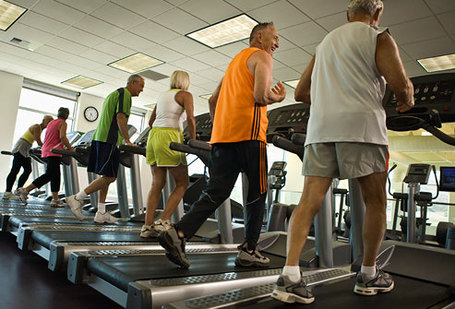http://gubernatrix.co.uk/2009/07/how-to-be-a-better-version-of-yourself/
It is a fact of life that some people are born with unusual physical beauty, in the same way that some people are born with a talent for writing or playing the violin. Someone else’s abilities on the violin have absolutely no bearing on yours, so why should someone else’s physical appearance have any bearing on yours?

Photo credit: Murdoch
The one thing that all the good training manuals say, but all the magazines don’t say, is that diet and training programmes must be individualised. We all start from a different basis of genetics, experience, capacity for work, personalities and lifestyles.
Magazines would prefer you to think that a celebrity’s diet or training programme can work the same way for you as it sells more magazines, but this is complete rubbish.
Some celebrities can seem to be more successful than so-called ordinary people at losing weight or getting ripped. But this is not because they are using some magic programme, this is because they are able to afford a highly individualised programme and have the energy and motivation to devote to it.
The fact is that you can also enjoy the same success if you employ these same principles: a programme designed around your needs and goals, a diet based on your lifestyle and approach to eating, plus the motivation to do it all properly – which comes from within you.
There are many ways to obtain these things. You can get expert help, by hiring a personal trainer and nutritionist. You can get support and advice by joining a diet or fitness club. You can design a diet and training programme yourself, by doing the research and teaching yourself the principles.
There are advantages and disadvantages to each route. You might think that hiring a personal trainer and nutritionist is the best route if you can afford it, but this is not necessarily the case. Learning it all yourself, while it might take longer, could be better for you in the long run. Over your lifetime, the knowledge that you have gained can be accessed for free at any time because it is in your head!
Celebrity culture
This is one of the most insidious and destructive aspects of modern (mostly) Western society. Celebrity culture can destroy people. It is vitally important that people stop wanting to look like celebrities and start wanting to look like a better version of themselves. For Christ’s sake, even celebrities don’t want to look like themselves! How many celebrities have you seen with wildly fluctuating weight, cosmetic surgery and drug use?
No-one could deny that looks are important to the majority of people but you should decide what you think looks good.
I believe it comes down to having respect for yourself as an individual. There is nothing wrong with wanting to change; in fact, this is often a very positive desire. But the focus must be on yourself and how you want yourself to look. Don’t picture a celebrity, picture a better version of yourself.
Can anyone lose weight? Yes. Can anyone put on muscle? Yes. But it may not happen in the way you think it is going to. You will learn a lot about yourself while going through the process and sometimes you will have to be realistic about your goals.
This is another reason why it is dangerous to have a celebrity as a model for your ideal look. It simply may not be possible for you to look like that. You may look great but in a different way. Always focus on the way you look.
Cutting through the crap
Not everyone wants to spend hours learning about training and nutrition in order to be able to create their own personalised programme. But you have to take responsibility for these things to a certain extent.
It is like healthy eating. You don’t have to go back to school and get a nutrition qualification but you should learn the basics and be able to make good choices when you go shopping. You must immunise yourself against marketing claims. Read the nutritional information but do not take any notice of unquantified and vague claims like “low fat” or “whole grain”, which mean nothing.
Trust your instincts. This is part of having respect for yourself and your own capacity to understand what is good and what is bad. I see people all the time getting terribly confused about what is the ‘right’ training programme or the ‘right’ type of food to eat. This is because they are desperately trying to remember what they read in a magazine or what someone told them they should be doing.
If you find yourself in this position, stop trying to remember what someone else said and try to work it out for yourself. This is not as difficult as it sounds.
Here are some simple questions to ask yourself:
- Are outrageous or unrealistic claims being made? Come on, you know you can’t achieve anything worthwhile in 10 minutes, right? If it was that easy, everyone would be doing it and everyone would be showing amazing results.
- Do the numbers add up? Often one particular number will be trumpeted, but check all the others to see if it actually makes sense. For example, 1% fat – but how much sugar? Unless it is a raw ingredient, too much of anything is likely to be suspect.
- Is it adaptable? Anything that is not adaptable to the individual should make you pause and consider. Very few things in life work in the same way for everyone. If adaptability is not built in, you can’t be sure it will work for you. It may be perfectly acceptable for matey over there but not for you.
- Is the product or service playing on your fears or uncertainties? Be suspicious of anything that plays on your fears or depicts disastrous scenarios if you don’t partake of it. This is usually marketing rubbish.
- Don’t assume that if something is right then everything else is wrong! This may sound unintuitive but it comes back to taking an individualised approach. For example, some people say you must eat breakfast, others say you don’t have to eat breakfast. There are scenarios where these are both right! So how do you tell the difference? Well, just be careful of absolutes. There are very few absolutes in life. If someone is telling you that you absolutely must do something, this may not be true. You are under no obligation to accept this without question just because someone chose to use strong language!
- Be suspicious of claims of “best” and “only”. The truth is that lots of things work. This is great news, it means that you can choose a method that works for you. Ultimately the only thing that is important is that it does work.
You’ll probably catch 90% of the crap just by going through this simple thought process.
The breakfast example
Let’s look at this more closely because it is an interesting one. If two seemingly opposite things are both right, how do you work out which is right for you?
The most thorough way would be to do a controlled experiment of both methods – but we don’t all have time to do that!
So you can take a shortcut (oh, and be suspicious of anyone who offers shortcuts!) by finding out the reasons behind the methods and deciding if those apply to you; in other words forming a hypothesis about which is more likely to be best, based on your knowledge of yourself - a topic on which you are a world expert.
In the breakfast example, the conventional wisdom is that eating a healthy breakfast is better than not because it stops you snacking and eating unhealthy food later in the day because you got hungry.
However there are also people who say it doesn’t matter what time you eat and how many times a day you eat, so long as you are eating healthy or ‘clean’ food and you are getting the right amount of calories or macronutrients in a given period of time. These people are often following an ‘intermittent fasting’ style of eating.
In each method, the desired outcome of controlling overall calories is the same and the principle of eating healthy food is the same. It is simply the tactic that is different. One tactic to avoid overeating is to eat at regular intervals, the other tactic to avoid overeating is not to eat for long periods of time.
In either case, eating unhealthy food or eating more than the required number of calories would constitute failure.
So you need to pick the tactic that you think would work for you, given your circumstances. Or try both and see which is best.
What I am saying is that there is nothing inherent in ‘breakfast’ that makes you healthier or thinner. This is why you need to find out what is behind the claims that people make. Remember, there are very few absolutes in life.
Conclusion

Photo credit: burntfilm
At the risk of sounding like a self help guru I believe the key to success is: learn, aspire, believe.
If you want to be slimmer, fitter and healthier, learn about it. What else in life did you achieve without any learning? You had to learn to read, drive your car, play your sport and carry out your trade.
Aspire to be a better version of yourself, not to be someone else. Aspiration is important because true aspirations generally start with being honest about yourself. Aspiring to be better comes from an understanding of where you are now. People who have no aspirations are perhaps kidding themselves about their current situation.
Believe in your ability to cut through the crap and make decisions for yourself. Believe in your ability to carry out a programme of work and get the outcome you want. Right this moment I am watching the Williams sisters playing in the Wimbledon final and I can see right in front of me the difference made by belief. They are both brilliant tennis players – you can’t choose between them where ability is concerned. But Serena has more belief right now and she is winning.
So go on, make it happen!


